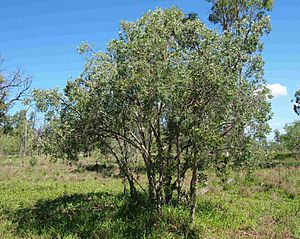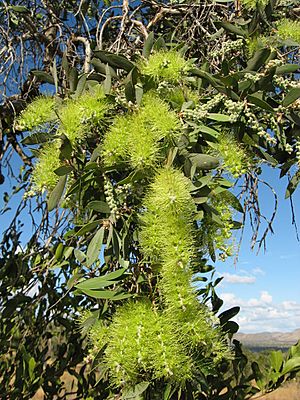Fibrebark facts for kids
Quick facts for kids Fibrebark |
|
|---|---|
 |
|
| M. nervosa habit | |
| Scientific classification | |
| Genus: |
Melaleuca
|
| Species: |
nervosa
|
| Synonyms | |
|
|
The Melaleuca nervosa, often called fibrebark, is a type of shrub or tree. It belongs to the myrtle family, called Myrtaceae. This plant grows naturally only in northern Australia. It's a tropical paperbark tree with narrow leaves. Its flowers can be yellow-green or red. Like some other melaleuca trees, the fibrebark has been very useful to Indigenous Australians.
Contents
What is Fibrebark?
Fibrebark trees can grow from 2 to 15 meters (about 6 to 49 feet) tall. They have straight branches and bark that feels like papery fibers. This bark can be grey, cream, brown, or white. The size and shape of the leaves can be different depending on the type of fibrebark.
Generally, the leaves are 30 to 115 mm (about 1 to 4.5 inches) long. They are also 5 to 40 mm (about 0.2 to 1.5 inches) wide. The leaves are tough and leathery. When they are young, they are covered with fine, silky hairs. Each leaf has 3 to 7 veins running along its length.
Fibrebark Flowers and Fruit
The flowers of the fibrebark grow in groups of three. These groups form long spikes, about 100 mm (4 inches) long and 50 mm (2 inches) wide. Inside each flower, there are five bundles of stamens. Stamens are the parts of the flower that make pollen. Each bundle has 3 to 7 stamens.
The flowers can be white, creamy-green, cream, yellow-green, or sometimes red. Fibrebark trees usually flower from April to September. After the flowers, the tree produces woody, cup-shaped fruits. These fruits are called capsules and are about 2 to 3 mm (0.08 to 0.12 inches) long and wide.
How Fibrebark Got Its Name
The fibrebark tree was first officially described in 1848. A scientist named John Lindley gave it the name Callistemon nervosum. This description was published in a book about an expedition to Australia. Later, in 1944, another scientist named Edwin Cheel changed its name to Melaleuca nervosa.
The name nervosa comes from a Latin word meaning "sinewy". This refers to the clear, strong veins you can see on the leaves of this plant. Today, many scientists consider Callistemon nervosus to be the same plant as Melaleuca nervosa.
Where Fibrebark Grows
This type of melaleuca tree is found in many places across northern Australia. You can see it in Queensland, north of Bundaberg. It also grows in the Northern Territory and the northern part of the Kimberley region in Western Australia.
Fibrebark can grow in many different environments. It likes sandy soils and areas near rivers and streams. You can also find it in wet, low-lying areas and even on red sand dunes.
Is Fibrebark Endangered?
In Western Australia, the Melaleuca nervosa is considered "not threatened". This means it is not in danger of disappearing. The Government of Western Australia's Department of Parks and Wildlife keeps track of its status.
Uses of Fibrebark
Fibrebark trees have been used for different purposes, from gardening to traditional practices.
Growing Fibrebark in Gardens
It's quite easy to grow new fibrebark trees from their seeds. The type with red flowers is often grown in places like Atherton because it looks very pretty. This plant can grow well in many different types of soil and weather conditions.
Traditional Uses by Indigenous Australians
The bark of the Melaleuca nervosa tree was very important to Indigenous Australians. They used it to make coolamons. These are special dishes or containers used for carrying food and other items. People could also get fresh water by cutting into the trunk of the tree.
The leaves of the fibrebark were used to help with stuffy noses. Oils taken from the leaves had similar uses to those from tea tree oil.


